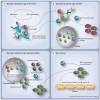How do natural killer T cells help B cells?
- PMID: 19627191
- PMCID: PMC2747240
- DOI: 10.1586/erv.09.56
How do natural killer T cells help B cells?
Abstract
CD1d-restricted natural killer (NKT) cells are important contributors to antigen-specific antibody responses. There is, therefore, considerable interest in the design and implementation of strategies to appropriately activate NKT cells and boost vaccine-induced protective antibody responses. In order to achieve these goals, investigators are examining the mechanisms by which NKT cells enhance antibody responses. Although information is limited, it is now appreciated that both cognate and noncognate interactions between CD1d-expressing B cells and NKT cells drive enhanced antibody responses. NKT cells may provide B-cell help in the form of direct receptor-mediated interactions as well as by secretion of soluble effectors, including cytokines. In this article, we review the evidence in support of these mechanisms and discuss how they likely take place in the context of interactions of NKT cells with other cell types, such as dendritic cells and helper T cells. We also discuss the evidence that NKT cells affect discrete differentiation events in the multistep process by which a naive B cell experiences antigen and develops into a memory B cell or an antibody-secreting plasma cell. Since most information on NKT cells and humoral immunity has been derived from murine studies, we discuss what is known about human NKT cells and humoral immunity. We offer thoughts on whether the findings in murine systems will translate to humans.
Figures


Similar articles
-
Natural killer T (NKT)-B-cell interactions promote prolonged antibody responses and long-term memory to pneumococcal capsular polysaccharides.Proc Natl Acad Sci U S A. 2013 Oct 1;110(40):16097-102. doi: 10.1073/pnas.1303218110. Epub 2013 Sep 16. Proc Natl Acad Sci U S A. 2013. PMID: 24043771 Free PMC article.
-
The Influence of Invariant Natural Killer T Cells on Humoral Immunity to T-Dependent and -Independent Antigens.Front Immunol. 2018 Feb 22;9:305. doi: 10.3389/fimmu.2018.00305. eCollection 2018. Front Immunol. 2018. PMID: 29520280 Free PMC article. Review.
-
CD40L-null NKT cells provide B cell help for specific antibody responses.Vaccine. 2011 Nov 15;29(49):9132-6. doi: 10.1016/j.vaccine.2011.09.060. Epub 2011 Sep 28. Vaccine. 2011. PMID: 21959330 Free PMC article.
-
Reduction of CD1d expression in vivo minimally affects NKT-enhanced antibody production but boosts B-cell memory.Int Immunol. 2011 Apr;23(4):251-60. doi: 10.1093/intimm/dxq477. Epub 2011 Mar 12. Int Immunol. 2011. PMID: 21398691 Free PMC article.
-
Vaccine Designs Utilizing Invariant NKT-Licensed Antigen-Presenting Cells Provide NKT or T Cell Help for B Cell Responses.Front Immunol. 2018 Jun 4;9:1267. doi: 10.3389/fimmu.2018.01267. eCollection 2018. Front Immunol. 2018. PMID: 29915600 Free PMC article. Review.
Cited by
-
Phenotypic identification of CD19+CD5+CD1d+ regulatory B cells that produce interleukin 10 and transforming growth factor β1 in human peripheral blood.Arch Med Sci. 2019 Sep;15(5):1176-1183. doi: 10.5114/aoms.2018.77772. Epub 2018 Aug 27. Arch Med Sci. 2019. PMID: 31572462 Free PMC article.
-
Immune Ecosystem of Virus-Infected Host Tissues.Int J Mol Sci. 2018 May 6;19(5):1379. doi: 10.3390/ijms19051379. Int J Mol Sci. 2018. PMID: 29734779 Free PMC article. Review.
-
Effect of Immune Cell Infiltration on Occurrence of Pulmonary Hypertension in Pulmonary Fibrosis Patients Based on Gene Expression Profiles.Front Med (Lausanne). 2021 Jul 7;8:671617. doi: 10.3389/fmed.2021.671617. eCollection 2021. Front Med (Lausanne). 2021. PMID: 34307406 Free PMC article.
-
Identification and validation of depression-associated genetic variants in the UK Biobank cohort with transcriptome and DNA methylation analyses in independent cohorts.Heliyon. 2025 Jan 10;11(2):e41865. doi: 10.1016/j.heliyon.2025.e41865. eCollection 2025 Jan 30. Heliyon. 2025. PMID: 39897774 Free PMC article.
-
Developing understanding of the roles of CD1d-restricted T cell subsets in cancer: reversing tumor-induced defects.Clin Immunol. 2011 Aug;140(2):184-95. doi: 10.1016/j.clim.2011.04.017. Epub 2011 May 13. Clin Immunol. 2011. PMID: 21646050 Free PMC article. Review.
References
-
- Porcelli SA, Modlin RL. The CD1 system: antigen-presenting molecules for T cell recognition of lipids and glycolipids. Annu Rev Immunol. 1999;17:297–329. - PubMed
-
- Mandal M, Chen XR, Alegre ML, et al. Tissue distribution, regulation and intracellular localization of murine CD1 molecules. Mol Immunol. 1998;35(9):525–536. - PubMed
-
- Zeng Z, Castano AR, Segelke BW, Stura EA, Peterson PA, Wilson IA. Crystal structure of mouse CD1: an MHC-like fold with a large hydrophobic binding groove. Science. 1997;277(5324):339–345. - PubMed
-
- Koch M, Stronge VS, Shepherd D, et al. The crystal structure of human CD1d with and without α-galactosylceramide. Nat Immunol. 2005;6(8):819–826. - PubMed
Publication types
MeSH terms
Substances
Grants and funding
LinkOut - more resources
Full Text Sources
